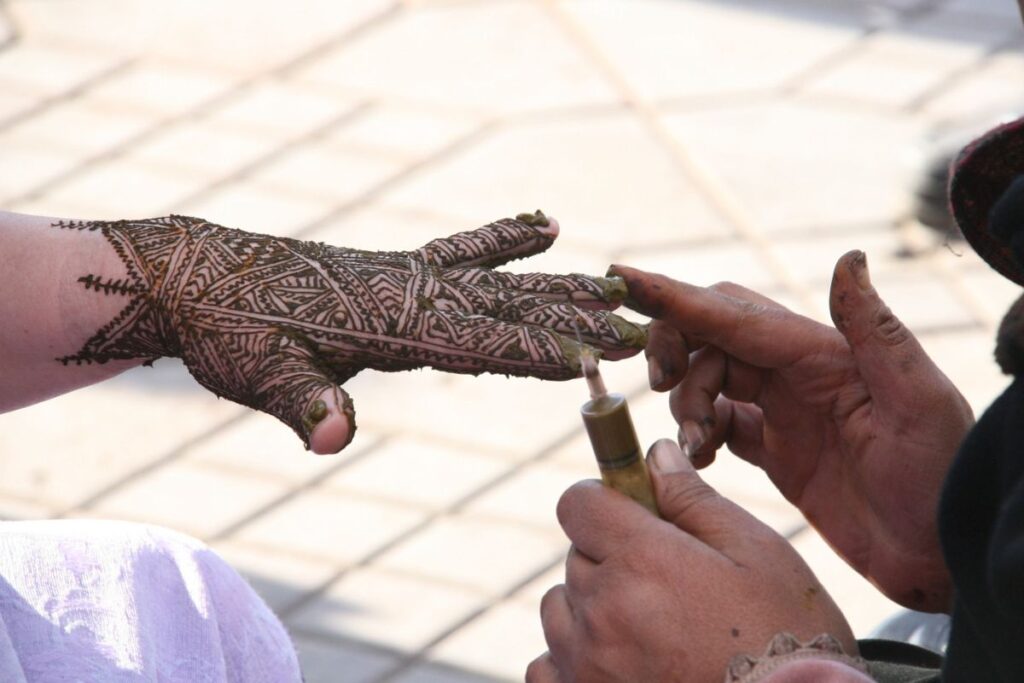Morocco, a country known for its rich cultural heritage and vibrant traditions, is a place where art and symbolism come to life through various forms. Among these, one of the most captivating and widely practiced art forms is henna. Henna, also known as “mehndi” in Arabic, is a form of body art that has deep cultural significance and a long history in Morocco. In this article, we will explore the art of henna in Morocco, its symbolism, and its application in both traditional and modern contexts.
Henna in Morocco: Cultural Significance and Modern Trends





A Tradition with Deep Roots
Henna has been used for centuries in Morocco and across North Africa and the Middle East. Its origins can be traced back to ancient Egypt, and it has since become an integral part of Moroccan culture and traditions. The practice of applying henna is commonly associated with celebrations and special occasions, such as weddings, festivals, and religious holidays.
Symbolism and Meanings
Henna art is not merely decorative; it is steeped in symbolism and cultural significance. Different patterns and motifs hold distinct meanings, making it a language of its own. Here are some of the common symbols and their meanings in Moroccan henna art:
- Floral Patterns: Flowers and floral patterns represent joy, happiness, and beauty. They are often used in bridal henna designs to symbolize love and prosperity.
- Vines and Leaves: Vines and leafy patterns are associated with growth, fertility, and renewal. They are used to bless newlyweds and expectant mothers.
- Geometric Shapes: Geometric patterns in henna symbolize balance, harmony, and protection. They are often used to ward off negative energy and promote positive vibes.
- Eyes: The “Nazar,” or the evil eye, is a protective symbol used to ward off bad luck and envy. Eyes are commonly incorporated into henna designs to protect the wearer from negative influences.
- Peacocks: Peacock motifs represent beauty and grace. In Moroccan henna art, they are often used to celebrate femininity and elegance.
- Fish: Fish symbolsize good luck and fertility. They are often used in henna designs for brides to bring luck and prosperity to their marriage.
The Application Process
The process of applying henna in Morocco is a meticulous and time-honored art. The henna paste is made from the leaves of the henna plant, which are dried and ground into a fine powder. The powder is then mixed with water, lemon juice, and essential oils to create a thick, aromatic paste.
The application of henna is typically done by skilled artists known as “hnayniyas” or “mehndi artists.” These artists use fine-tipped cones or brushes to draw intricate designs on the skin. The henna paste is left to dry, and as it dries, it leaves behind a reddish-brown stain. The longer the paste is left on the skin, the deeper and more long-lasting the color.
Traditional Occasions for Henna
Henna plays a central role in various traditional Moroccan celebrations:
- Weddings: Moroccan weddings are incomplete without henna. The bride and female members of both the bride and groom’s families adorn their hands and feet with intricate henna designs. It is a symbol of joy, love, and the bride’s transition into her new life.
- Eid Al-Fitr and Eid Al-Adha: These Islamic holidays are occasions for family gatherings and celebrations. Many Moroccans apply henna to mark the festivities and express their joy.
- Festivals: Morocco hosts numerous festivals throughout the year, and henna art is often a part of the cultural displays and activities during these events.
Henna in Modern Morocco
While henna remains deeply rooted in Moroccan traditions, it has also found its way into modern life. Many Moroccan women, and even some men, choose to apply henna for personal expression and as a form of body art. Henna is not limited to special occasions; it has become a fashion statement and a means of self-expression.
Moreover, henna has gained popularity as a tourist attraction in Morocco. Tourists often seek out local henna artists to have temporary henna tattoos applied to their hands or arms as a way to experience this traditional art form firsthand.
Challenges and Precautions
It’s important to note that not all henna used in Morocco is natural or safe. Some commercially available henna pastes may contain harmful additives or synthetic dyes. Tourists and individuals interested in getting henna should exercise caution and seek out reputable artists who use natural, chemical-free henna paste.
The art of henna in Morocco is a living tradition that bridges the gap between the past and the present. It is a form of self-expression, cultural celebration, and personal adornment that continues to thrive in Moroccan society. With its intricate designs and rich symbolism, henna remains a captivating and cherished art form that beautifully reflects the cultural richness of Morocco. Whether applied for weddings, festivals, or personal expression, henna is a true testament to the enduring traditions and creativity of this North African nation.
Secure Your Adventure: Book Now for the Ultimate Moroccan Tour!
Book now and start the best tour with us! Discover the wonders of Morocco with our expertly crafted itineraries, tailored to provide an unforgettable experience. From breathtaking landscapes to rich cultural heritage, our tours offer the perfect blend of adventure and relaxation. Don’t wait – secure your spot today and embark on the journey of a lifetime!
